Top ten classic jet engines in the world and their future prospects(HY-industry technical centre)
Top ten classics
For more than 80 years, jet engines have been bumpy and innovative. If you list it, there are actually countless innovation points, but if you want to browse it quickly. Then the following 10 innovation actions can be considered as typical cases.
-
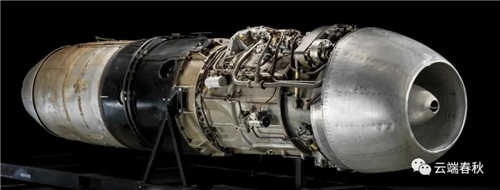 Juncker Youmo 004B, Germany: Yumo 004B has always been called the “Prince of Turbojet”. It is the world’s first mass-produced turbojet jet engines, mass production began in 1944, and the output exceeded 5,000 units during World War II. The main equipment is Me 262 and Arado Ar 234. The Germans have used many innovative technologies on the 004B, such as hollow turbine blades and auxiliary fuel injection. The Germans are even preparing to use afterburning systems. 004B weighs about 1600 pounds and has a thrust of 1980 pounds. Converting the push-to-weight ratio is about 1.2. This is the beginning of the jet era.
Juncker Youmo 004B, Germany: Yumo 004B has always been called the “Prince of Turbojet”. It is the world’s first mass-produced turbojet jet engines, mass production began in 1944, and the output exceeded 5,000 units during World War II. The main equipment is Me 262 and Arado Ar 234. The Germans have used many innovative technologies on the 004B, such as hollow turbine blades and auxiliary fuel injection. The Germans are even preparing to use afterburning systems. 004B weighs about 1600 pounds and has a thrust of 1980 pounds. Converting the push-to-weight ratio is about 1.2. This is the beginning of the jet era. -
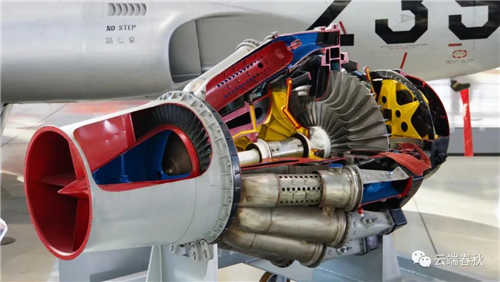 General Electric I-40/J-33: The centrifugal turbojet engine used by the P-80 “Meteor” fighter is an improved version of I-16/J-31. I-40/J-33 began to use a large number of special alloy materials. Inconel is used for the combustion chamber, chromium-cobalt-tungsten carbide (Stellite) is used for the turbine nozzle, and nickel-based superalloy (Hastelloy B) is used for the turbine disk. It weighs 1850 pounds and has a thrust of 4000 pounds. It can be further increased to 5400 pounds by spraying water and alcohol. The thrust-to-weight ratio is close to 3. I-40 is the first mass-produced jet engines that uses jet water and alcohol to boost power.
General Electric I-40/J-33: The centrifugal turbojet engine used by the P-80 “Meteor” fighter is an improved version of I-16/J-31. I-40/J-33 began to use a large number of special alloy materials. Inconel is used for the combustion chamber, chromium-cobalt-tungsten carbide (Stellite) is used for the turbine nozzle, and nickel-based superalloy (Hastelloy B) is used for the turbine disk. It weighs 1850 pounds and has a thrust of 4000 pounds. It can be further increased to 5400 pounds by spraying water and alcohol. The thrust-to-weight ratio is close to 3. I-40 is the first mass-produced jet engines that uses jet water and alcohol to boost power. -
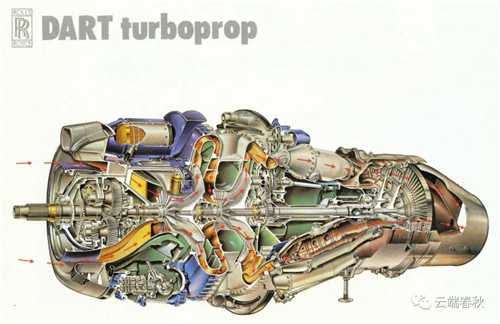 1946 Rollo “Dart” turboprop engine: If the turbo power of the turbojet engine is used to drive the accelerator to drive the propeller, rather than generating strong recoil power, then such an engine is a turboprop engine. The Rollo RB.53 “Dart” (Dart) that appeared in 1946 was an early masterpiece of a turboprop engine. It is the power system of Vickers “Viscount”-the world’s first commercial passenger aircraft in operation. “Dart” has been produced from the late 1940s to 1987, which is considered to be a very long-life turboprop engine.
1946 Rollo “Dart” turboprop engine: If the turbo power of the turbojet engine is used to drive the accelerator to drive the propeller, rather than generating strong recoil power, then such an engine is a turboprop engine. The Rollo RB.53 “Dart” (Dart) that appeared in 1946 was an early masterpiece of a turboprop engine. It is the power system of Vickers “Viscount”-the world’s first commercial passenger aircraft in operation. “Dart” has been produced from the late 1940s to 1987, which is considered to be a very long-life turboprop engine. -
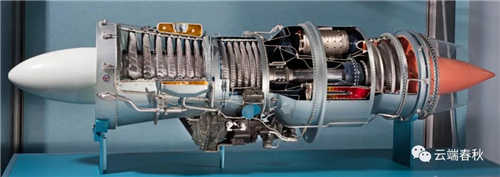 Pratt and Whitney J-57: Based on JT-3 (JT-3 is the power of Boeing 707 and Douglas DC-8) developed in 1953, J-57 is the world’s first axial-flow jet engines with dual rotor design , With very good acceleration performance. J-57 is also the world’s first engine with more than 10,000 pounds of thrust. The compressor and turbine of JT-3 are divided into a low-pressure section and a high-pressure section, which are connected to each other through two long shafts nested in each other to achieve two rotation speeds of the low-pressure section and the high-pressure section. This innovation has significantly improved engine performance.
Pratt and Whitney J-57: Based on JT-3 (JT-3 is the power of Boeing 707 and Douglas DC-8) developed in 1953, J-57 is the world’s first axial-flow jet engines with dual rotor design , With very good acceleration performance. J-57 is also the world’s first engine with more than 10,000 pounds of thrust. The compressor and turbine of JT-3 are divided into a low-pressure section and a high-pressure section, which are connected to each other through two long shafts nested in each other to achieve two rotation speeds of the low-pressure section and the high-pressure section. This innovation has significantly improved engine performance. -
 General Electric J79: The engine should adapt to various working environments, and the internal flow field environment can be adjusted ideally. The General Electric 1J79, introduced in 1955, was the first to adopt an adjustable stator design. By adjusting the angle of the intake air deflector, the engine was kept in good working condition in a wider environment. J79 is a single-shaft design, using a 17-stage compressor and a 3-stage turbine. It weighs 3850 pounds, with a thrust of 11,905 pounds, afterburner thrust of 17,835 pounds, and a thrust-to-weight ratio of 4.6
General Electric J79: The engine should adapt to various working environments, and the internal flow field environment can be adjusted ideally. The General Electric 1J79, introduced in 1955, was the first to adopt an adjustable stator design. By adjusting the angle of the intake air deflector, the engine was kept in good working condition in a wider environment. J79 is a single-shaft design, using a 17-stage compressor and a 3-stage turbine. It weighs 3850 pounds, with a thrust of 11,905 pounds, afterburner thrust of 17,835 pounds, and a thrust-to-weight ratio of 4.6 -
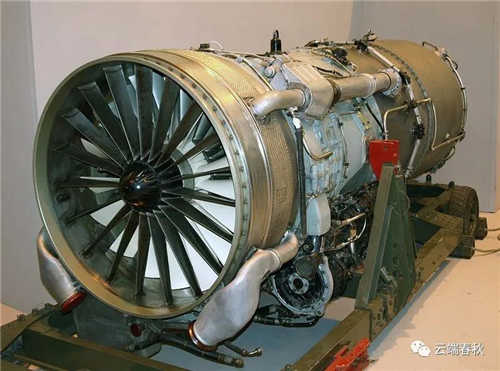 1960s Rolls-Royce “Conway” turbofan engine: In the study of jet engines, it was found that if the turbojet engine opened a loop slit at the front end of the compressor, a part of the air flowed from the outside of the hot end, the engine economy was improved. This is the germination of the original turbofan concept. The Rolls-Royce “Conway” engine put into use in the 1960s became the world’s first mass-produced turbofan engine. It uses a dual-rotor design, is equipped with a 16-stage compressor and a 3-stage turbine, weighs 4,544 pounds, and has a thrust of 17,500 pounds, making it a very economical power system.
1960s Rolls-Royce “Conway” turbofan engine: In the study of jet engines, it was found that if the turbojet engine opened a loop slit at the front end of the compressor, a part of the air flowed from the outside of the hot end, the engine economy was improved. This is the germination of the original turbofan concept. The Rolls-Royce “Conway” engine put into use in the 1960s became the world’s first mass-produced turbofan engine. It uses a dual-rotor design, is equipped with a 16-stage compressor and a 3-stage turbine, weighs 4,544 pounds, and has a thrust of 17,500 pounds, making it a very economical power system. -
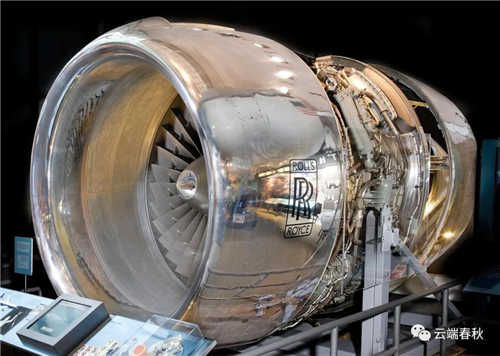 1969 Rolls-Royce RB211 three-rotor turbofan engine: In the era of dual-rotor turbofan engines, the British tried to continue to achieve the speed diversity of the rotor system. On the basis of the two-stage sleeve shaft, an additional sleeve shaft is tried to realize a three-rotor system. This is the unique secret of the RB211 engine. But the challenge of this unique skill burned 170 million pounds at the time, almost making Roro bankrupt. The British government took over Luoluo at a critical moment and nationalized it, and finally let Luoluo complete RB211. With a thrust of 59,000 pounds, the RB211 has become a model of power for large commercial aircraft. The “Trent” series of aero-engines derived from RB211 and its three-rotor technology have laid the leading position of Luo Luo in the next half century.
1969 Rolls-Royce RB211 three-rotor turbofan engine: In the era of dual-rotor turbofan engines, the British tried to continue to achieve the speed diversity of the rotor system. On the basis of the two-stage sleeve shaft, an additional sleeve shaft is tried to realize a three-rotor system. This is the unique secret of the RB211 engine. But the challenge of this unique skill burned 170 million pounds at the time, almost making Roro bankrupt. The British government took over Luoluo at a critical moment and nationalized it, and finally let Luoluo complete RB211. With a thrust of 59,000 pounds, the RB211 has become a model of power for large commercial aircraft. The “Trent” series of aero-engines derived from RB211 and its three-rotor technology have laid the leading position of Luo Luo in the next half century. -
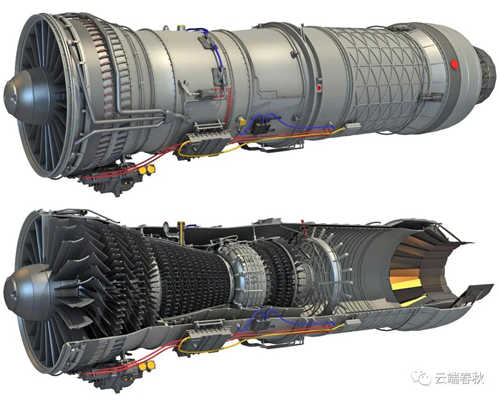 1970s Pratt & Whitney F100: The Pratt & Whitney F100 twin-rotor turbofan engine developed in the 1970s was the first military engine to increase the thrust-to-weight ratio to nearly 8. It uses a 13-stage compressor and a 4-stage turbine with a dual rotor design. F100 is not only reflected in the step of pushing the weight ratio, but also in the long and difficult process of development and improvement. It took almost 30 years from development to maturity. It fully embodies the difficult challenges of modern advanced aeroengine development.
1970s Pratt & Whitney F100: The Pratt & Whitney F100 twin-rotor turbofan engine developed in the 1970s was the first military engine to increase the thrust-to-weight ratio to nearly 8. It uses a 13-stage compressor and a 4-stage turbine with a dual rotor design. F100 is not only reflected in the step of pushing the weight ratio, but also in the long and difficult process of development and improvement. It took almost 30 years from development to maturity. It fully embodies the difficult challenges of modern advanced aeroengine development. -
 1990s Pratt & Whitney F119 turbofan engine: the first turbofan engine with 9-stage thrust-to-weight ratio. F119 is the crystallization of long-term investment in pre-research of aviation power in the United States. It adopts dual shaft design, 9-stage compressor and two-stage counter-rotating turbine. It weighs 3900 pounds and has a thrust of 35,000 pounds. The F-22’s supersonic cruising ability depends almost entirely on it.
1990s Pratt & Whitney F119 turbofan engine: the first turbofan engine with 9-stage thrust-to-weight ratio. F119 is the crystallization of long-term investment in pre-research of aviation power in the United States. It adopts dual shaft design, 9-stage compressor and two-stage counter-rotating turbine. It weighs 3900 pounds and has a thrust of 35,000 pounds. The F-22’s supersonic cruising ability depends almost entirely on it. -
 2000s Pratt & Whitney PW1000G geared fan engine: The multi-speed system of the rotor system is a good way to improve the economy of the engine. Through research, it is found that the big fan of commercial engines is urgently needed to adjust the speed-currently its speed is too large, in fact, it needs to be lower. The traditional method of directly driving with the central longitudinal axis cannot slow down, because the compressor behind cannot slow down. Pratt & Whitney proposed a new method of driving fans with planetary gear trains, resulting in the PW1000G series of geared turbofan engines. In this way, three speeds of fan, low-pressure compressor/low-pressure turbine, and high-pressure compressor/high-pressure turbine are realized, which improves the economy of the engine.
2000s Pratt & Whitney PW1000G geared fan engine: The multi-speed system of the rotor system is a good way to improve the economy of the engine. Through research, it is found that the big fan of commercial engines is urgently needed to adjust the speed-currently its speed is too large, in fact, it needs to be lower. The traditional method of directly driving with the central longitudinal axis cannot slow down, because the compressor behind cannot slow down. Pratt & Whitney proposed a new method of driving fans with planetary gear trains, resulting in the PW1000G series of geared turbofan engines. In this way, three speeds of fan, low-pressure compressor/low-pressure turbine, and high-pressure compressor/high-pressure turbine are realized, which improves the economy of the engine.
Future
The future aero engine may be more complicated and has a strange shape, but several basic development directions are still very clear
-
More adjustable parts. The stator is adjustable, is the rotor also adjustable? It cannot be done at present and may be realized in the future. If the stator and rotor of the engine can be adjusted, the performance of the engine will be greatly improved.
-
The culvert can vary. The current bypass ratio of the engine is immutable. However, if the duct is changed like a Transformer, the shape of the cavity can be changed, or an adjustable valve channel is provided between the inner and outer ducts, then the change of the duct ratio can be achieved. Once that’s the case, the engine’s development space is widened at once. But this change relies on new materials and new processes, as well as new overall design theories.
-
 Electronic intelligent control. At present, the engine already has a full authority digital electronic control system (FADEC), and this system may be intelligent in the future. For example, in the case of a single-engine failure of a twin-engine aircraft, if the pilot makes an error and shuts down the intact engine, the system will decisively refuse to execute the order to ensure the normal operation of the only engine. Of course, this requires artificial intelligence to become stable enough.
Electronic intelligent control. At present, the engine already has a full authority digital electronic control system (FADEC), and this system may be intelligent in the future. For example, in the case of a single-engine failure of a twin-engine aircraft, if the pilot makes an error and shuts down the intact engine, the system will decisively refuse to execute the order to ensure the normal operation of the only engine. Of course, this requires artificial intelligence to become stable enough. -
The most challenging direction is to subvert the working mechanism of traditional engines. However, this point is really unclear. At present, there are many theories and still need to be tested by practice. Often in the fog of invisible and unclear, the power of revolution is hidden.
-
The development of aero-engines requires a fairly complete industrial education ecosystem to provide the human and technical resources needed, and billions of dollars or even higher funds, not to mention. The establishment of such an industrial education ecosystem is a major issue. For countries with low levels of industrialization and industrial civilization, and low levels of educational and cultural development, it is almost impossible to complete the task. China’s aero-engine research and development can speed up after the 1990s, thanks to the continuous accumulation of industrialization and educational achievements brought about by the reform and opening up.
-
The aero engine is not a project with quick results. Practicing aviation engine technology is more like practicing Chinese kung fu. In the face of the secret, only one year and 30 years of practice will have small achievements. But the more difficult problem is that others will not give you the secret of the engine. Your secret can only be pondered by yourself and you can write it yourself. Whether it is written correctly or not depends on continuous practice to check and adjust. Can’t you practice? If you want to become a powerful country in science and technology, you can’t do without advanced aviation engines. This technology is a necessary ability to become the ideal of a powerful country in science and technology.

